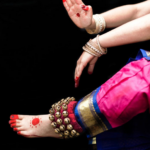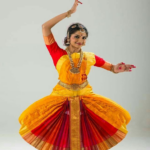
The Timeless Beauty of Bharatanatyam Jewelry
The Bharatanatyam jewelry worn by the dancers is known for its intricate designs, reflecting traditional motifs and craftsmanship. The Bharatanatyam ornaments are typically worn by female performers and play a significant role in enhancing the overall look of the dancer.
Typically, Bharatanatyam jewelry is made of maroon or dark green Kemp (red colored) stones, also known as temple jewelry. The Devadasis and maharanis who wore traditional Kemp jewelry in the past have inspired such renditions of the Bharatanatyam ornaments.
A Deep Dive into the Intricate Bharatnatyam jewelry
Historical Context
The origins of Bharatanatyam jewelry are deeply rooted in South India’s temple culture, where the dance form originated and was initially performed by devadasis. The jewelry worn by these dancers has symbolic and spiritual significance, often reflecting their role as servants of the deity
The ornaments for Bharatanatyam were inspired by traditional South Indian temple jewelry, which was crafted to replicate the kind of ornaments that the idols of the deities wore in the temple.
During the early period when Bharatanatyam was performed exclusively in temples, the jewelry was simple and carried deep cultural and religious significance. It was often made with gold and inlaid with semi-precious stones and pearls.
During the royal patronage, the jewelry became heavier and more ornate, often made entirely of gold and embedded with precious gemstones such as rubies, diamonds and emeralds. However, this grand trend saw a decline during the colonial period with the emergence of Christianity. Fewer people crafted and wore such heavy and expensive jewelry.
Modern-day Bharatanatyam jewelry is made up of lighter and more affordable materials which have room for customization and creativity. Gold-plated jewelry and costume jewelry made of more affordable materials is often used, which is lighter in weight and modern in style.
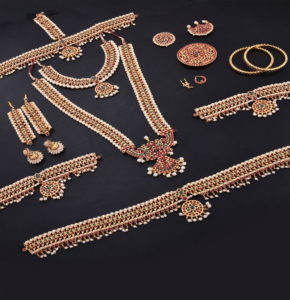
1) The Founder of the Costume and Bharatanatyam Ornaments
Rukmini Devi Arundale, a legendary Bharatanatyam dancer, conceptualized the various costumes that are worn by Bharatanatyam dancers today and designed Bharatanatyam jewelry that complimented these costumes and was traditional as well.
2) Different Varieties of Bharatanatyam Jewelry
- Tallaisaamana
One of the most distinctive pieces of Bharatanatyam jewelry is the ‘Tallaisamana’, a three-part decorative piece with a circular bindi attached to the central part, which lands right over the dancer’s forehead. This ‘bindi’ or ‘Talaisamana’ is worn on the head and forehead, enhancing the beauty of facial expressions during the dance.
- Chandra-Surya
On either side of their head, a dancer wears the ‘Chandra-Surya’, the moon and the sun. They are represented in the form of replicas of the celestial objects. These ornaments, crafted from sparkling stones, pearls, and other motifs, frame the central bindi.
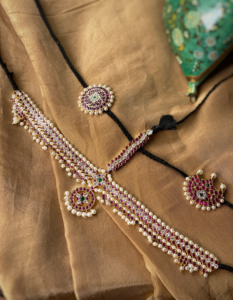
- The Hair Accessories : Rakodi and Gajra
Another key piece of Bharatanatyam jewelry, the headgear won by the dancer over the bun at the back of the head, is called ‘Rakodi’, tied at the back. Adorning the bun is a ‘Gajra’, a garland of white or orange flowers that is arranged around the bun, adding a touch of natural beauty.
- A plethora of necklaces as elemental Bharatanatyam Ornaments:
– A dancer’s neck is adorned with multiple necklaces. A short necklace called the ‘Attikai’ sits close to the neck. A longer, integratedly designed, heavy necklace called ‘Muttumalai’ is positioned right about the waistband of the dancer. Studded with precious stones or made of pearls, Muttumalai flaunts as a central pendant. Another necklace made of small golden overlapping circular discs called ‘Kashumalai’, popularly known as ‘Kashimala’, is added.
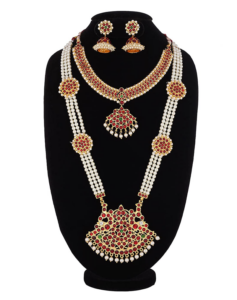
- Bharatanatyam Jewelry for the hands and ears
– Vivid-colored bangles ‘Valaila’, consistent with the colour theme of the saree, are worn by the dancers, combining them with other bangles made of pearls or gold.
– The earrings ‘Jimikka’ dangle from the ears of the dancer, consisting of a wider base made of pearls. To accompany the earrings, gorgeous ear chains called ‘Matil’ or ‘Mattil’ are used, embedded with traditional motifs and kemp red stones complementing the overall theme of Bharatanatyam ornaments and costumes.
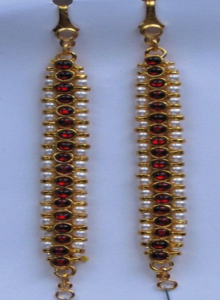
- The Nose Embellishments
The nose is decorated with two kinds of Bharatanatyam jewelry, one consisting of a small nose ring studied with stones called ‘Nattu’ and a unique ornament called ‘Bullakku’, worn between the nostrils.
- The Odiyanam
Another key element in the Bharatanatyam jewelry is Odiyanam/Ottiyanam, a golden belt worn around the waist. This belt helps to secure the drape of the dancer’s costume, particularly the pallu of the saree or the upper garment, and ensure a strong posture.
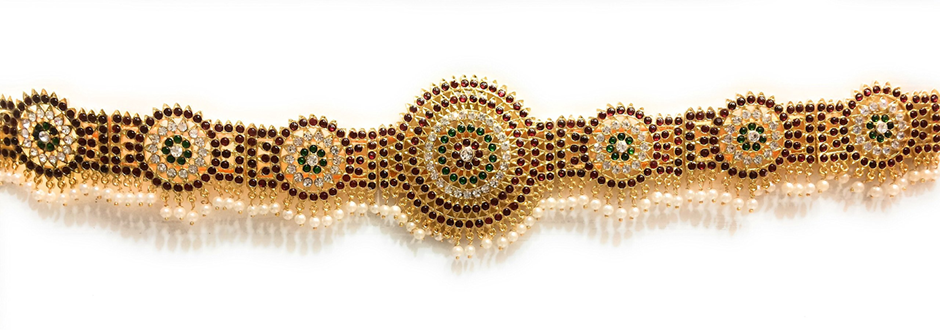
- The Sacred Red
– The Alta
To highlight the hand gestures (mudras) and the footwork of the dancer, the hands and feet are colored with ‘alta’ or ‘marutani’, a red dye or Henna. In Bharatanatyam, a specific design is followed when applying the ‘alta’ such that a circle is drawn in the centre of the palm of the hand and the finger tips are covered with the dye. The vibrant red colour emphasizes the precision of each step and mudra, making them more visually appealing.
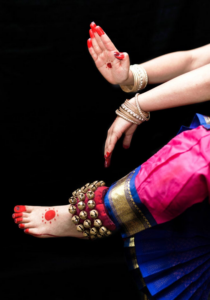
– The Kumkuma
On the forehead, a sacred red dot known as the ‘Kumkuma’ or ‘Vasukutti’ is applied, shifting the focus of the audience towards the centre of the dancer’s eyes.
3) The Tradition of Ghungroos
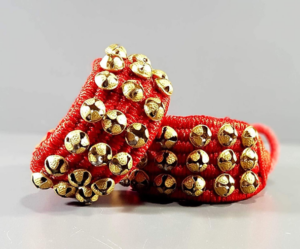
- Ghungroo, also known as ankle bells, are an essential aspect of Bharatanatyam. These bells accentuate the rhythmic footwork as the dancer synchronizes their movements with the beats of the tala.
- The sound of the ghungroo amplifies the impact of the dancer’s footsteps, making the rhythm an integral part of the performance. The number of rows of bells varies according to the dancer’s skill level.
- The ghungroos are worn by three levels of dancers: intermediates wear three rows, advanced dancers wear five rows, and novices wear two rows. The gradual increase in the rows of the bells signify the dancer’s progression in mastering the art.
4) Bharatanatyam Ornaments for Male Dancers
The male dancers wear minimal jewelry. The upper part of the body of a male dancer is bare, often adorned with minimal jewelry, such as a central long pendant and a short necklace ‘Attikai’. Often, dancers flaunt the ‘Vanki Bajuband’(Arm decoration) made of pearls and tied around both arms. The waist belt ‘Odiyanam’ and ghungroos, with a bright red tika on the forehead, complete the look of a male Bharatanatyam dancer.
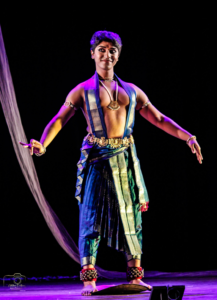
Symbolism and Meaning
The Bharatanatyam jewelry worn by dancers isn’t just an ornamental edition but is deeply symbolic and carries profound meanings, reflecting themes and narratives of the performance.
The use of several traditional motifs, such as the lotus motif representing purity, beauty, and spiritual enlightenment, is used in necklaces adorned with lotus-shaped pendants that symbolize the dancer’s connection to the divine beauty and purity of the dance. Headpieces incorporating Lotus motifs are also seen as an excellent addition to the theme.
Other designs, such as a peacock as a symbol of beauty, grace, and elegance, were incorporated into the earrings, nose rings, or hair ornaments of the dancers.
Peacock patterns in the Oddiyanam (waistband) were used to symbolise grace and fluidity in the movements of the dancer. The motifs of Ganesha and other deities to symbolise wisdom and prosperity were often used in bracelets, bangles, and necklaces. The sun and moon, used to depict balance and harmony, are worn on the head of the dancer.
Tips for choosing Bharatanatyam Jewelry
While choosing Bharatanatyam jewelry for a performance, there are some key elements that we need to look at.
- Choosing jewelry that compliments the colour and style of the costume helps enhance the visual appeal of the dance, such as choosing gold sets with temple motifs that match traditional attire or opting for simpler designs that work with modern or fusion outfits.
- Opt for lightweight, comfortable jewelry, such as imitation sets or gold-plated jewelry for easier and lighter experience
- jewelry with secure ties and clasps are to be preferred.
Maintaining your Jewelry
Regular cleaning and maintenance of the jewelry can ensure it’s shine and durability.
- Cleaning of the jewelry using a soft cloth and water, while avoiding harsh soaps and chemicals works best.
- Storage of the jewelry in soft cloth pouches or boxes separately, to prevent scratches and tarnishing.
- Avoiding moisture and perfumes near the jewelry to ensure its shine.
- Regular maintenance and repair of the jewelry for loose stones and clasps can extend its life.
Bharatanatyam jewelry accentuates the intricate movements, hand mudras, and other features, drawing attention to the dancer’s eyes, neck, hands, and feet, where much of the expression and movement are concentrated. These pieces of Bharatanatyam jewelry work together to not only enhance the visual beauty of the dance but to honour the traditional culture of Bharatanatyam.
You can elevate your Bharatanatyam performance with the timeless beauty of authentic Bharatanatyam jewelry by discovering the stories behind each piece and design and learning how jewelry may enhance the grace and expression of your dance. Dive into our expert guidance sessions and find the perfect jewelry that resonates with you!


